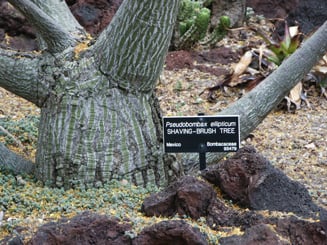

Contributor
- Topics: Archive, Plants You Need

Caudiciform plants form a caudex—a fat, swollen stem, trunk, or aboveground roots. Plants in this category sport colorful names like elephant’s foot, Buddha belly, pregnant onion, and turtle back. Caudiciform plants number in the hundreds, and almost as many gardening clubs are devoted to their unusual architectural forms.

The diversity of form may surprise the casual caudex fan. Besides the many bonsai and houseplant selections, many of which are succulents, caudiciforms are represented among trees, vines, and even a few grasses and bulbs. Although many caudiciform genera are uncommon, you’ll find caudex selections in such familiar genera as Euphorbia, Aloe, Cissus, Agapetes, and Cussonia. Most commercially grown caudiciforms hail from desert regions of Africa or Mexico. Their distinctive structure is a survival mechanism; the fat stems store water when it is plentiful for the plant to use over the long dry season.
Many caudiciform plants are also classified as pachycauls, derived from Greek pachy, which means thick, and Latin caulis, or stem. Pachycauls often have few branches in proportion to their thick trunks.
Some Favorite Fat Plants
• Desert rose (Adenium obesum). A succulent pachycaul shrub sporting thick stems and a swollen basal caudex with leathery, spirally arranged leaves that sprout from the tips of the branches. Tubular, flaring flowers are typically red or pink and very showy. (Zone 11, bonsai)

• Red paperdrops (Agapetes serpens). Many gardeners grow this decorative shrub without realizing that the plant forms an interesting and sometimes tangled caudex. This blueberry relative (Ericaceae) is an epiphyte—it grows on other plants for support—and sports beautiful dripping, papery red flowers. (Zone 9, shrub)
• Maiden’s quiver tree (Aloe ramosissima). As this profusely branched Aloe from South Africa matures, it develops a leathery caudex that gives the plant an ancient appearance. It is easily grown in a container. (Zone 10a, bonsai)

• Ponytail palm (Beaucarnea recurvata). The familiar ponytail palm forms a distinctive, sculpted, fat trunk more quickly than most caudiciforms. The trunk produces terminal tufts of strap-shaped, recurved, bright green, leathery leaves. The plant is native to Mexico where 300-year-old specimens can be found. (Zone 9a, houseplant)
• Queensland bottle tree (Brachychiton rupestris). This easy-to-grow tree is a natural candidate for bonsai, though it takes a few years for the trunk to swell. In the ground, the tree can reach 40 feet with a trunk diameter of 6 feet. (Zone 9, bonsai)
• Elephant tree (Bursera microphylla). A member of the frankincense family that is native to northwestern Mexico and the American southwest, elephant tree is a favorite of caudex collectors. The tree’s delicate leaves are very fragrant, while quick growth and a distinctive trunk add to its appeal. (Zone 9a, tree)
• Rock cabbage tree (Cussonia natalensis). You’ll want to grow this South African member of the Aralia family as much for its ornamental, palm-shaped leaves that grow in large rounded heads, as for the fat trunk. Another plus, the foliage turns gold in the fall. Fast growing. (Zone 10, tree/bonsai)
• Tree grape (Cyphostemma juttae). Tree grape features unusually white trunks that are one of the fattest caudiciforms relative to their overall size. A member of the grape family (Vitaceae), the plant’s attractive leaves are fleshy and prominently serrated with purplish new growth. (Zone 9a, bonsai)

• Elephant foot/turtle back (Dioscorea elephantipes). This summer-deciduous, geophytic climber in the yam family sports a unique, deeply fissured surface that resembles a fat pineapple or, to some people, an elephant’s foot. Though it grows slowly, it is a favorite of caudex collectors. (Zone 9b, bonsai)
• Baseball plant (Euphorbia obesa). Here, the entire spherical plant is the caudex. Young plants are spherical but become more cylindrical with age. Typical of the species, the plant’s eight ridged segments resemble the stitching on a baseball. (Zone 11a, succulent, bonsai, houseplant)
• Hottentot bread (Fockea edulis). Vining stems emerge from a pale, warty caudex. This geophytic plant grows more quickly if the caudex is covered with soil. Older plants have fewer stems relative to their caudex size. (Zone 9a, houseplant)

• Ocotillo (Fouquieria fasciculata). This spiny Mexican shrub is prized for its dwarf size, fat swollen base, and the way the green leaves and bark frame a wealth of large, copper-colored spines. (Zone 8a, shrub, bonsai)
• Buddha belly (Jatropha podagrica). This Euphorbiaceae member showcases lush foliage, a short round caudex, and showy flowers that attract butterflies. The plant is self-fertile, and contains both male and female flowers. When ripe seedpods burst, they cast easy-to-germinate seeds several feet away. (Zone 9a, bonsai)
• Pregnant onion (Albuca bracteata, syn. Ornithogalum longibracteatum). This unique caudiciform is commonly called star of Bethlehem. It forms a fat, onion-like white caudex, from which soft, strap-shaped green leaves sprout. Star-shaped green and white flowers appear along tall stems in summer. (Zone 9a, houseplant)

• Ming aralia (Polyscias fruticosa). This common houseplant is an evergreen shrub or dwarf tree native to India. A good caudiciform for beginners, the plant features a soft, corky caudex and delicate, fern-like foliage. (Zone 10b, houseplant)

• Shaving brush tree (Pseudobombax ellipticum). Native to Central America, this tree’s calling card is its bulbous, tortoise shell-like trunk with fissured gray bark. Very large, palmate green leaves give it a tropical look. Green sepals peel back to expose shaving brush-like white stamens. (Zone 9b, tree)

For more information consult your local nursery professional or www.bihrmann.com/caudiciforms.
Share:
Social Media
Garden Futurist Podcast
Most Popular
Videos
Topics
Related Posts

Low Maintenance Gardens – Better for Pollinators and People
Autumn 2022 “I come out every day. It’s therapy, my meditation.” Janet’s young garden transformed from overgrown, invasive plants to mostly natives. The dailiness of

Invasive Plants Are Still Being Sold: Preventing Noxious Weeds in Your Landscape
Autumn 2022 With so many beautiful ornamental plant species and cultivars throughout California and the Pacific Northwest, how do you decide which ones to include

Garden Design in Steppe with Transforming Landscapes with Garden Futurist Emmanuel Didier
Summer 2022 Listen to full Garden Futurist: Episode XVII podcast here. Emmanuel Didier, Principal and Creative Director at Didier Design Studio is a leading figure

Seslerias: Versatile Groundcover Meadow Grasses
Summer 2022 Without question, the most beautiful and versatile of all the groundcover meadow grasses are the moor grasses (Sesleria). Moor grasses tick off all










Responses